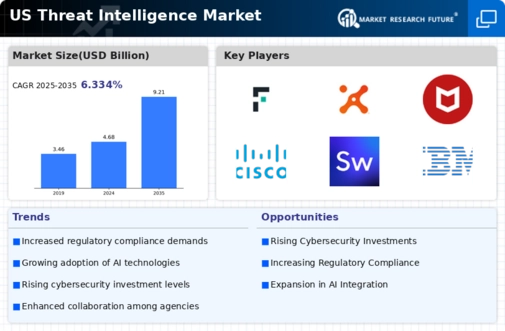The threat intelligence-management market is characterized by a dynamic competitive landscape, driven by the increasing sophistication of cyber threats and the growing demand for proactive security measures. Major players such as CrowdStrike (US), FireEye (US), and Palo Alto Networks (US) are at the forefront, each adopting distinct strategies to enhance their market positioning. CrowdStrike (US) emphasizes innovation through its cloud-native platform, focusing on AI-driven threat detection and response capabilities. FireEye (US), on the other hand, leverages its extensive threat intelligence database to provide comprehensive security solutions, while Palo Alto Networks (US) is concentrating on expanding its portfolio through strategic acquisitions and partnerships, particularly in the realm of cloud security. Collectively, these strategies contribute to a competitive environment that is increasingly focused on technological advancement and integrated security solutions.
In terms of business tactics, companies are increasingly localizing their operations to better serve regional markets and optimize supply chains. The market structure appears moderately fragmented, with a mix of established players and emerging startups vying for market share. This fragmentation allows for diverse offerings, yet the influence of key players remains substantial, as they set industry standards and drive innovation.
In October 2025, CrowdStrike (US) announced a strategic partnership with a leading cloud service provider to enhance its threat intelligence capabilities. This collaboration is expected to bolster its AI-driven analytics, allowing for more rapid identification and mitigation of threats. Such partnerships are crucial as they enable CrowdStrike (US) to leverage external expertise and resources, thereby enhancing its competitive edge in a rapidly evolving market.
In September 2025, FireEye (US) launched a new suite of threat intelligence services aimed at small to medium-sized enterprises (SMEs). This move is significant as it reflects a growing recognition of the need for tailored security solutions for smaller organizations, which often lack the resources to implement comprehensive security measures. By addressing this market segment, FireEye (US) positions itself as a leader in democratizing access to advanced threat intelligence.
In August 2025, Palo Alto Networks (US) completed the acquisition of a cybersecurity startup specializing in machine learning algorithms for threat detection. This acquisition is indicative of the ongoing trend towards AI integration within the industry, as it enhances Palo Alto Networks' (US) capabilities in predictive analytics and automated threat response. Such strategic moves are likely to redefine competitive dynamics, as companies that effectively harness AI technology may gain a substantial advantage.
As of November 2025, current trends in the threat intelligence-management market include a pronounced shift towards digitalization, with companies increasingly adopting AI and machine learning to enhance their security postures. Strategic alliances are becoming more prevalent, as organizations recognize the value of collaboration in addressing complex cyber threats. Looking ahead, competitive differentiation is expected to evolve, with a greater emphasis on innovation and technology rather than price-based competition. Companies that prioritize reliability in their supply chains and invest in cutting-edge technologies are likely to emerge as leaders in this rapidly changing landscape.

















Leave a Comment